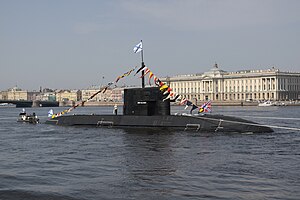Russian submarine Sankt Peterburg (B-585)

Sankt Peterburg in 2010
|
|
| History | |
|---|---|
|
|
|
| Name: | B-585 Sankt Peterburg |
| Namesake: | City of Saint Petersburg |
| Ordered: | Unknown |
| Builder: | Admiralty Shipyard |
| Laid down: | 26 December 1997 |
| Launched: | 28 October 2004 |
| Commissioned: | 6 May 2010 |
| Status: | in active service |
| General characteristics | |
| Class and type: | St. Petersburg-class diesel-electric submarine |
| Displacement: | 2,800 tons submerged; 1,675 tons surfaced |
| Beam: | 7.1 m (23 ft 4 in) |
| Draft: | 6.5 m (21 ft 4 in) |
| Speed: | 10 knots (19 km/h; 12 mph) surfaced; 21 knots (39 km/h; 24 mph) submerged |
| Range: | 1,050 kilometres (650 mi) submerged at cruising speed |
| Endurance: | 45 days |
| Test depth: | 300 m (984 ft) |
| Complement: | 35 |
| Armament: | 6 x 533 millimetres (21.0 in) torpedo tubes for 18 x torpedoes or missiles or 44 x mines |
B-585 Sankt Peterburg (Russian: Б-585 «Санкт-Петербург»; named after Saint Petersburg) is the lead boat of the St. Petersburg class of the Russian Navy. The Lada class is the fourth generation of diesel-electric submarines designed and constructed in the former Soviet Union and Russia to replace the Kilo class. Construction of the boat started in December 1997, and she was launched in October 2004. After undergoing a series of sea trials, Sankt Peterburg was commissioned in May 2010. However, the Russian Navy decided not to accept the St. Petersburg class after it was discovered that the boat's propulsion and sonar systems were inadequate. After design corrections the submarine was accepted. In 2014, Sankt Peterburg joined the Northern Fleet.
Sankt Peterburg is first boat of Rubin Design Bureau's Lada class, of which a total of eight were expected to be procured by the Russian Navy. A less capable version, the Amur class, is marketed for export. Designed during the 1990s, the St. Petersburg class is intended to be the successor to the larger Kilo class. The Kilo class is considered to be one of the quietest diesel classes in operations, giving rise to the nickname "Black Hole". Among the expected capabilities improvements of the St. Petersburg class over its predecessor were the incorporation of improved anechoic coating (to minimize sonar contact), extended cruise range, and the upgrade to newer weapons for anti-submarine and anti-ship operations. St. Petersburg-class boats can also conduct reconnaissance and defend naval facilities and sea lanes.
...
Wikipedia
